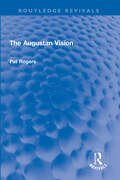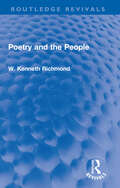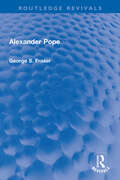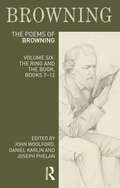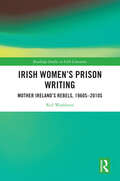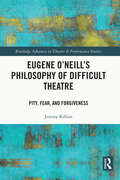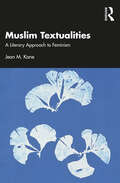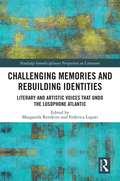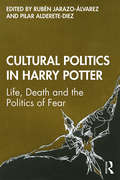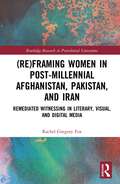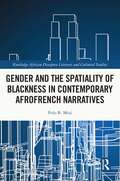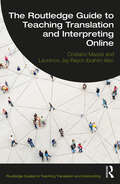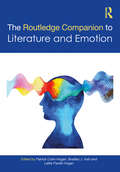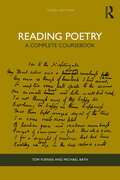- Table View
- List View
The Augustan Vision (Routledge Revivals)
by Pat RogersFirst published in 1974, The Augustan Vision looks at the entire spectacle of Augustan Society in an attempt to see English culture as a whole and thus gain greater insight into this critical period in English Literature. Later parts of the book explore poetry, drama, and aesthetics; that distinctive expression of the age, satire, where abuse is made into art, and the moral essay; and finally, the emerging novel, the crucial new form of this period. This is a must read for students and researchers of English literature.
Poetry and the People (Routledge Revivals)
by W. Kenneth RichmondFirst published in 1947, Poetry and the People presents a survey of English poetry from the earliest times till 1940s, viewed from an unusual angle. It is the author’s thesis that English Poetry is unpopular, in the sense that it is not loved by the people, because the sources of its inspiration, which were originally drawn from the soil, were diverted during the Renaissance into aristocratic and academic channels. Nevertheless, the emerging traditions, though driven underground, survived in the work of such men as Burns, Hogg and Clare and in folk song. This book is a must read for scholars and researchers of English poetry and English literature.
The Augustan Vision (Routledge Revivals)
by Pat RogersFirst published in 1974, The Augustan Vision looks at the entire spectacle of Augustan Society in an attempt to see English culture as a whole and thus gain greater insight into this critical period in English Literature. Later parts of the book explore poetry, drama, and aesthetics; that distinctive expression of the age, satire, where abuse is made into art, and the moral essay; and finally, the emerging novel, the crucial new form of this period. This is a must read for students and researchers of English literature.
Alexander Pope (Routledge Revivals)
by G.S. FraserFirst published in 1978, Alexander Pope is an introduction to Pope’s life and work, which sets the poet solidly in his age and relates the liveliness and variety of his poetry to the strange combination of chronic invalidism and a sociable disposition which marked his life. G. S. Fraser argues that Pope is a more varied figure than his reputation as a great satirist indicates and that he is in some ways more a survivor from the Restoration than a precursor of middle-class morality. Special attention is paid to the poems in the first Collected Works of 1717, which displays both Pope’s gaiety and his sense of colour and beauty. The dignity of his translation of Homer and the thoughtfulness and piety of An Essay on Man are also emphasised. His satirical genius, which found its greatest expression during the later years of declining health, is not ignored but set in perspective. Many readers of this persuasively argued study will be surprised to discover in it a gayer, more warm-hearted and more likeable Pope than they had, perhaps, imagined. Students of English literature will find this book immensely refreshing.
Alexander Pope (Routledge Revivals)
by G.S. FraserFirst published in 1978, Alexander Pope is an introduction to Pope’s life and work, which sets the poet solidly in his age and relates the liveliness and variety of his poetry to the strange combination of chronic invalidism and a sociable disposition which marked his life. G. S. Fraser argues that Pope is a more varied figure than his reputation as a great satirist indicates and that he is in some ways more a survivor from the Restoration than a precursor of middle-class morality. Special attention is paid to the poems in the first Collected Works of 1717, which displays both Pope’s gaiety and his sense of colour and beauty. The dignity of his translation of Homer and the thoughtfulness and piety of An Essay on Man are also emphasised. His satirical genius, which found its greatest expression during the later years of declining health, is not ignored but set in perspective. Many readers of this persuasively argued study will be surprised to discover in it a gayer, more warm-hearted and more likeable Pope than they had, perhaps, imagined. Students of English literature will find this book immensely refreshing.
The Poems of Robert Browning: The Ring and the Book, Books 7-12 (Longman Annotated English Poets)
by John Woolford Daniel Karlin Joseph PhelanThe Ring and the Book, published serially in 1868–9, is one of the most daring and innovative poems in the English language. The story is based on the trial of an Italian nobleman, Guido Franceschini, for the murder of his wife Pompilia in Rome in 1698. Browning’s discovery of the ‘old yellow book’, a bundle of legal documents and letters relating to the trial, on a second-hand market stall in Florence, sparked an imaginative engagement with this sordid tale of domestic cruelty, adultery, and greed which grew, through four years of arduous labour, into an epic peopled not by gods and warriors but by concrete, recognizably human beings. Fusing the technique of the dramatic monologue, the form he had made his own, with the grandeur of classical epic and the vivid realism of the modern novel, Browning created a unique hybrid form that allowed him not only to bring to life an entire historical period but also to reflect on the process of artistic creation itself —the forging of the golden ‘ring’ of the poem from the ‘pure crude fact’ of its historical original. This edition, comprising volumes 5 and 6 in the acclaimed Longman Annotated English Poets edition of Browning’s poems, does full justice to the scope and depth of Browning’s achievement. The headnote in volume 5 gives an authoritative account of the poem’s composition, publication, sources, and reception, making use of hitherto unpublished letters and textual material. In addition to giving readers help, where needed, with historical and linguistic comprehension, the notes track Browning’s formidable range of allusion, from the most erudite to the most vulgar. The appendices in volume 6 present a selection from the original sources, a list of variants from extant proofs, and key passages from Browning’s fascinating and revealing correspondence with one of the earliest readers of the poem, Julia Wedgwood. The aim is to enable readers not just to understand the poem as an object of study, but to take pleasure in its abounding intellectual and emotional energies.
The Poems of Robert Browning: The Ring and the Book, Books 7-12 (Longman Annotated English Poets)
by John Woolford Daniel Karlin Joseph PhelanThe Ring and the Book, published serially in 1868–9, is one of the most daring and innovative poems in the English language. The story is based on the trial of an Italian nobleman, Guido Franceschini, for the murder of his wife Pompilia in Rome in 1698. Browning’s discovery of the ‘old yellow book’, a bundle of legal documents and letters relating to the trial, on a second-hand market stall in Florence, sparked an imaginative engagement with this sordid tale of domestic cruelty, adultery, and greed which grew, through four years of arduous labour, into an epic peopled not by gods and warriors but by concrete, recognizably human beings. Fusing the technique of the dramatic monologue, the form he had made his own, with the grandeur of classical epic and the vivid realism of the modern novel, Browning created a unique hybrid form that allowed him not only to bring to life an entire historical period but also to reflect on the process of artistic creation itself —the forging of the golden ‘ring’ of the poem from the ‘pure crude fact’ of its historical original. This edition, comprising volumes 5 and 6 in the acclaimed Longman Annotated English Poets edition of Browning’s poems, does full justice to the scope and depth of Browning’s achievement. The headnote in volume 5 gives an authoritative account of the poem’s composition, publication, sources, and reception, making use of hitherto unpublished letters and textual material. In addition to giving readers help, where needed, with historical and linguistic comprehension, the notes track Browning’s formidable range of allusion, from the most erudite to the most vulgar. The appendices in volume 6 present a selection from the original sources, a list of variants from extant proofs, and key passages from Browning’s fascinating and revealing correspondence with one of the earliest readers of the poem, Julia Wedgwood. The aim is to enable readers not just to understand the poem as an object of study, but to take pleasure in its abounding intellectual and emotional energies.
Irish Women's Prison Writing: Mother Ireland’s Rebels, 1960s–2010s (Routledge Studies in Irish Literature)
by Red WashburnThis book explores 50 years of Irish women’s prison writing, 1960s–2010s, connecting the work of women leaders and writers in Northern Ireland during the Troubles. This volume analyzes political communiqués, petitions, news coverage, prison files, personal letters, poetry and short prose, and memoirs, highlighting the personal correspondence, auto/biographical narratives, and poetry of the following key women: Bernadette McAliskey, Eileen Hickey, Mairéad Farrell, Síle Darragh, Ella O’Dwyer, Martina Anderson, Dolours Price, Marian McGlinchey (formerly Marian Price), Áine and Eibhlín Nic Giolla Easpaig (Ann and Eileen Gillespie), Roseleen Walsh, and Margaretta D’Arcy. This text builds on different fields and discourses to reimagine gender and genre as central to an interdisciplinary and intersectional prison archive. Centering Irish women’s prison writings, in order to challenge canonization in history and literature, this volume argues that women’s lives and words offer a different view of gender and nation as well as offer a fuller and more inclusive archive of Irish history and literature. Additionally, this book will point to the ways in which their politics of everyday life and their cultural work is a form of anti-colonial civil rights feminism, for it speaks truth to power in a world in which compliance and silence are valued. Overall, this text focuses on rethinking and recasting women’s voices and words in order to document and promote the ongoing Irish freedom struggle from an abolitionist feminist perspective.
Irish Women's Prison Writing: Mother Ireland’s Rebels, 1960s–2010s (Routledge Studies in Irish Literature)
by Red WashburnThis book explores 50 years of Irish women’s prison writing, 1960s–2010s, connecting the work of women leaders and writers in Northern Ireland during the Troubles. This volume analyzes political communiqués, petitions, news coverage, prison files, personal letters, poetry and short prose, and memoirs, highlighting the personal correspondence, auto/biographical narratives, and poetry of the following key women: Bernadette McAliskey, Eileen Hickey, Mairéad Farrell, Síle Darragh, Ella O’Dwyer, Martina Anderson, Dolours Price, Marian McGlinchey (formerly Marian Price), Áine and Eibhlín Nic Giolla Easpaig (Ann and Eileen Gillespie), Roseleen Walsh, and Margaretta D’Arcy. This text builds on different fields and discourses to reimagine gender and genre as central to an interdisciplinary and intersectional prison archive. Centering Irish women’s prison writings, in order to challenge canonization in history and literature, this volume argues that women’s lives and words offer a different view of gender and nation as well as offer a fuller and more inclusive archive of Irish history and literature. Additionally, this book will point to the ways in which their politics of everyday life and their cultural work is a form of anti-colonial civil rights feminism, for it speaks truth to power in a world in which compliance and silence are valued. Overall, this text focuses on rethinking and recasting women’s voices and words in order to document and promote the ongoing Irish freedom struggle from an abolitionist feminist perspective.
Eugene O'Neill's Philosophy of Difficult Theatre: Pity, Fear, and Forgiveness (Routledge Advances in Theatre & Performance Studies)
by Jeremy KillianThrough a close re-examination of Eugene O’Neill’s oeuvre, from minor plays to his Pulitzer-winning works, this study proposes that O’Neill’s vision of tragedy privileges a particular emotional response over a more “rational” one among his audience members. In addition to offering a new paradigm through which to interpret O’Neill’s work, this book argues that O’Neill’s theory of tragedy is a robust account of the value of difficult theatre as a whole, with more explanatory scope and power than its cognitivist counterparts. This paradigm reshapes our understanding of live theatrical tragedy’s impact and significance for our lives. The book enters the discussion of tragic value by way of the plays of Eugene O’Neill, and through this study, Killian makes the case that O’Neill has refused to allow Plato to define the terms of tragedy’s merit, as the cognitivists have. He argues that O’Neill’s theory of tragedy is non-cognitive and locates the value of a play in its ability to trigger certain emotional responses from the audience. This would be of great interest to students and scholars of performance studies, literature and philosophy.
Eugene O'Neill's Philosophy of Difficult Theatre: Pity, Fear, and Forgiveness (Routledge Advances in Theatre & Performance Studies)
by Jeremy KillianThrough a close re-examination of Eugene O’Neill’s oeuvre, from minor plays to his Pulitzer-winning works, this study proposes that O’Neill’s vision of tragedy privileges a particular emotional response over a more “rational” one among his audience members. In addition to offering a new paradigm through which to interpret O’Neill’s work, this book argues that O’Neill’s theory of tragedy is a robust account of the value of difficult theatre as a whole, with more explanatory scope and power than its cognitivist counterparts. This paradigm reshapes our understanding of live theatrical tragedy’s impact and significance for our lives. The book enters the discussion of tragic value by way of the plays of Eugene O’Neill, and through this study, Killian makes the case that O’Neill has refused to allow Plato to define the terms of tragedy’s merit, as the cognitivists have. He argues that O’Neill’s theory of tragedy is non-cognitive and locates the value of a play in its ability to trigger certain emotional responses from the audience. This would be of great interest to students and scholars of performance studies, literature and philosophy.
Muslim Textualities: A Literary Approach to Feminism
by Jean M. KaneIn the first decade of the twenty-first century, Muslim women writers located in Europe and American entered the cultural mainstream. Literary and visual productions negotiated static visual emblems of Islam, most prominently "the veil." They did so not by rejecting veiling practices, but by adapting Muslim resources, concepts and visual tradition to empowerment narratives in popular media. Mainstream reception of their works has often overlooked or misread these negotiations. Muslim Textualities argues for more flexible and capacious interpretation, with particular attention to visibility as a metaphor for political agency and to knowledge of cultural contexts. This provocative volume aims to articulate Muslim female agency through clear and accessible analysis of the theory and concepts driving the interpretation of these works. Scholars interested in the working representations of Muslim women, feminist subjectivities, and the complexities of gender roles, patriarchy, and feminism will find this volume of particular interest.
Muslim Textualities: A Literary Approach to Feminism
by Jean M. KaneIn the first decade of the twenty-first century, Muslim women writers located in Europe and American entered the cultural mainstream. Literary and visual productions negotiated static visual emblems of Islam, most prominently "the veil." They did so not by rejecting veiling practices, but by adapting Muslim resources, concepts and visual tradition to empowerment narratives in popular media. Mainstream reception of their works has often overlooked or misread these negotiations. Muslim Textualities argues for more flexible and capacious interpretation, with particular attention to visibility as a metaphor for political agency and to knowledge of cultural contexts. This provocative volume aims to articulate Muslim female agency through clear and accessible analysis of the theory and concepts driving the interpretation of these works. Scholars interested in the working representations of Muslim women, feminist subjectivities, and the complexities of gender roles, patriarchy, and feminism will find this volume of particular interest.
Challenging Memories and Rebuilding Identities: Literary and Artistic Voices that undo the Lusophone Atlantic (Routledge Interdisciplinary Perspectives on Literature)
by Margarida Rendeiro Federica LupatiTaking an original approach, Challenging Memories and Rebuilding Identities: Literary and Artistic Voices that undo the Lusophone Atlantic explores a selected body of cultural works from Portugal, Brazil and Lusophone Africa. Contributors from various fields of expertise examine the ways contemporary writers, artists, directors, and musicians explore canonical forms in visual arts, cinema, music and literature, and introduce innovation in their narratives, at the same time they discuss the social and historical context they belong to.
Cultural Politics in Harry Potter: Life, Death and the Politics of Fear
by Rubén Jarazo-Álvarez Pilar Alderete-DiezCultural Politics in Harry Potter: Life, Death and the Politics of Fear is the first book-length analysis of topics, such as death, fear and biopolitics in J.K. Rowling’s work from controversial and interdisciplinary perspectives. This collection brings together recent theoretical and applied cultural studies and focuses on three key areas of inquiry: (1) wizarding biopolitics and intersected discourses; (2) anxiety, death, resilience and trauma; and (3) the politics of fear and postmodern transformations. As such, this book: provides a comprehensive overview of national and gender discourses, as well as the transiting bodies in-between, in relation to the Harry Potter books series and related multimedia franchise; situates the transformative power of death within the fandom, transmedia and film depictions of the Potterverse and critically deconstructs the processes of subjectivation and legitimation of death and fear; examines the strategies and mechanisms through which cultural and political processes are managed, as well as reminding us how fiction and reality intersect at junctions, such as terrorism, homonationalism, materialism, capitalism, posthumanism and technology. Exploring precisely what is cultural about wizarding politics, and what is political about culture, this book is key reading for students of contemporary literature, media and culture, as well as anyone with an interest in the fictional universe and wizarding world of Harry Potter.
**Missing**: Remediated Witnessing in Literary, Visual, and Digital Media (Routledge Research in Postcolonial Literatures)
by Rachel Gregory FoxThis book critically examines the representational politics of women in post-millennial Afghanistan, Pakistan, and Iran across a range of literary, visual, and digital media. Introducing the conceptual model of remediated witnessing, the book contemplates the ways in which meaning is constructed, deconstructed, and reconstructed as a consequence of its (re)production and (re)distribution. In what ways is information reframed? The chapters in this book therefore analyse the reiterative processes via which Afghan, Pakistani, and Iranian women are represented in a range of contemporary media. By considering how Muslim women have been exploited as part of neo-imperial, state, and patriarchal discourses, the book charts possible—and unexpected—routes via which Muslim women might enact resistance. What is more, it asks the reader to consider how they, themselves, embody the role of witness to these resistant subjectivities, and how they might do so responsibly, with empathy and accountability.
**Missing**: Remediated Witnessing in Literary, Visual, and Digital Media (Routledge Research in Postcolonial Literatures)
by Rachel Gregory FoxThis book critically examines the representational politics of women in post-millennial Afghanistan, Pakistan, and Iran across a range of literary, visual, and digital media. Introducing the conceptual model of remediated witnessing, the book contemplates the ways in which meaning is constructed, deconstructed, and reconstructed as a consequence of its (re)production and (re)distribution. In what ways is information reframed? The chapters in this book therefore analyse the reiterative processes via which Afghan, Pakistani, and Iranian women are represented in a range of contemporary media. By considering how Muslim women have been exploited as part of neo-imperial, state, and patriarchal discourses, the book charts possible—and unexpected—routes via which Muslim women might enact resistance. What is more, it asks the reader to consider how they, themselves, embody the role of witness to these resistant subjectivities, and how they might do so responsibly, with empathy and accountability.
Gender and the Spatiality of Blackness in Contemporary AfroFrench Narratives (Routledge African Diaspora Literary and Cultural Studies)
by Polo B. MojiThis book approaches the study of AfroEurope through narrative forms produced in contemporary France, a location which richly illustrates race in European spaces. The book adopts a transdiciplinary lens that combines critical black and urban geographies, intersectional feminism, and textual analysis to explore the spatial negotiations of black women in France. It assesses literature, film, and music as narrative forms and engages with the sociocultural and political contexts from which they emerge. Through the figure of the black flâneuse and the analytical framework of "walking as method", the book goes beneath spectacular representations of ghettoised banlieues, televised protests, and shipwrecked migrants to analyse the spatiality of blackness in the everyday. It argues that the material-discursive framing of black flânerie, as both relational and embodied movements, renders visible a politics of place embedded in everyday mico-struggles of raced-sexed subjects. Foregrounding expressive modes and forms that have traditionally received little critical attention outside of the French and francophone world, this book will be relevant to academics, researchers, writers, students, activists, and readers with interests in Literary and Cultural Studies, African and Afrodiasporic Studies, Black Feminisms, Migration Studies, Critical Black Geographies, Francophone Studies, and the comparative framework of Afroeuropean Studies.
Gender and the Spatiality of Blackness in Contemporary AfroFrench Narratives (Routledge African Diaspora Literary and Cultural Studies)
by Polo B. MojiThis book approaches the study of AfroEurope through narrative forms produced in contemporary France, a location which richly illustrates race in European spaces. The book adopts a transdiciplinary lens that combines critical black and urban geographies, intersectional feminism, and textual analysis to explore the spatial negotiations of black women in France. It assesses literature, film, and music as narrative forms and engages with the sociocultural and political contexts from which they emerge. Through the figure of the black flâneuse and the analytical framework of "walking as method", the book goes beneath spectacular representations of ghettoised banlieues, televised protests, and shipwrecked migrants to analyse the spatiality of blackness in the everyday. It argues that the material-discursive framing of black flânerie, as both relational and embodied movements, renders visible a politics of place embedded in everyday mico-struggles of raced-sexed subjects. Foregrounding expressive modes and forms that have traditionally received little critical attention outside of the French and francophone world, this book will be relevant to academics, researchers, writers, students, activists, and readers with interests in Literary and Cultural Studies, African and Afrodiasporic Studies, Black Feminisms, Migration Studies, Critical Black Geographies, Francophone Studies, and the comparative framework of Afroeuropean Studies.
The Routledge Guide to Teaching Translation and Interpreting Online (Routledge Guides to Teaching Translation and Interpreting)
by Cristiano Mazzei Laurence Jay-Rayon Ibrahim AiboRoutledge Guides to Teaching Translation and Interpreting is a series of practical guides to key areas of translation and interpreting for instructors, lecturers, and course designers. The Routledge Guide to Teaching Translation and Interpreting Online is for educators of translation and interpreting teaching online in a variety of curricular combinations: fully online, partially online, hybrid, multimodal, or face-to-face with online components. Offering suggestions for the development of curriculum and course design in addition to online tools that can be used in skill-building activities, and adaptable to specific instructional needs, this textbook is suitable for both multilingual and language-specific classes. Fully comprehensive, the book addresses the tenets and importance of process-oriented pedagogy for students of translation and interpreting, best practices in online curriculum and course design, instructor online presence, detailed illustrations of specific online assignments, the importance of regular and timely feedback, and teaching across the online translation and interpreting (T&I) curriculum. Written by two experienced translators, interpreters, and scholars who have been teaching online for many years and in various settings, this book is an essential guide for all instructors of translation and interpreting as professional activities and academic disciplines.
The Routledge Guide to Teaching Translation and Interpreting Online (Routledge Guides to Teaching Translation and Interpreting)
by Cristiano Mazzei Laurence Jay-Rayon Ibrahim AiboRoutledge Guides to Teaching Translation and Interpreting is a series of practical guides to key areas of translation and interpreting for instructors, lecturers, and course designers. The Routledge Guide to Teaching Translation and Interpreting Online is for educators of translation and interpreting teaching online in a variety of curricular combinations: fully online, partially online, hybrid, multimodal, or face-to-face with online components. Offering suggestions for the development of curriculum and course design in addition to online tools that can be used in skill-building activities, and adaptable to specific instructional needs, this textbook is suitable for both multilingual and language-specific classes. Fully comprehensive, the book addresses the tenets and importance of process-oriented pedagogy for students of translation and interpreting, best practices in online curriculum and course design, instructor online presence, detailed illustrations of specific online assignments, the importance of regular and timely feedback, and teaching across the online translation and interpreting (T&I) curriculum. Written by two experienced translators, interpreters, and scholars who have been teaching online for many years and in various settings, this book is an essential guide for all instructors of translation and interpreting as professional activities and academic disciplines.
The Routledge Companion to Literature and Emotion (Routledge Literature Companions)
by Patrick Colm Hogan Bradley J. Irish Lalita Pandit HoganThe Routledge Companion to Literature and Emotion shows how the "affective turn" in the humanities applies to literary studies. Deftly combining the scientific elements with the literary, the book provides a theoretical and topical introduction to reading literature and emotion. Looking at a variety of formats, including novels, drama, film, graphic fiction, and lyric poetry, the book also includes focus on specific authors such as Shakespeare, Chaucer, Jane Austen, Virginia Woolf, and Viet Thanh Nguyen. The volume introduces the theoretical groundwork, covering such categories as affect theory, affective neuroscience, cognitive science, evolution, and history of emotions. It examines the range of emotions that play a special role in literature, including happiness, fear, aesthetic delight, empathy, and sympathy, as well as aspects of literature (style, narrative voice, and others) that bear on emotional response. Finally, it explores ethical and political concerns that are often intertwined with emotional response, including racism, colonialism, disability, ecology, gender, sexuality, and trauma. This is a crucial guide to the ways in which new, interdisciplinary understandings of emotion and affect—in fields from neuroscience to social theory—are changing the study of literature and of the ways those new understandings are impacted by work on literature also.
The Routledge Companion to Literature and Emotion (Routledge Literature Companions)
by Patrick Colm Hogan Bradley J. Irish Lalita Pandit HoganThe Routledge Companion to Literature and Emotion shows how the "affective turn" in the humanities applies to literary studies. Deftly combining the scientific elements with the literary, the book provides a theoretical and topical introduction to reading literature and emotion. Looking at a variety of formats, including novels, drama, film, graphic fiction, and lyric poetry, the book also includes focus on specific authors such as Shakespeare, Chaucer, Jane Austen, Virginia Woolf, and Viet Thanh Nguyen. The volume introduces the theoretical groundwork, covering such categories as affect theory, affective neuroscience, cognitive science, evolution, and history of emotions. It examines the range of emotions that play a special role in literature, including happiness, fear, aesthetic delight, empathy, and sympathy, as well as aspects of literature (style, narrative voice, and others) that bear on emotional response. Finally, it explores ethical and political concerns that are often intertwined with emotional response, including racism, colonialism, disability, ecology, gender, sexuality, and trauma. This is a crucial guide to the ways in which new, interdisciplinary understandings of emotion and affect—in fields from neuroscience to social theory—are changing the study of literature and of the ways those new understandings are impacted by work on literature also.
Reading Poetry: A Complete Coursebook
by Tom Furniss Michael BathReading Poetry offers a comprehensive and accessible guide to the art of reading poetry. Discussing more than 200 poems by more than 100 writers, ranging from ancient Greece and China to the twenty-first century, the book introduces readers to the skills and the critical and theoretical awareness that enable them to read poetry with enjoyment and insight. This third edition has been significantly updated in response to current developments in poetry and poetic criticism, and includes many new examples and exercises, new chapters on ‘world poetry’ and ‘eco-poetry’, and a greater emphasis throughout on American poetry, including the impact traditional Chinese poetry has had on modern American poetry. The seventeen carefully staged chapters constitute a complete apprenticeship in reading poetry, leading readers from specific features of form and figurative language to larger concerns with genre, intertextuality, Caribbean poetry, world poetry, and the role poetry can play in response to the ecological crisis. The workshop exercises at the end of each chapter, together with an extensive glossary of poetic and critical terms, and the number and range of poems analysed and discussed – 122 of which are quoted in full – make Reading Poetry suitable for individual study or as a comprehensive, self-contained textbook for university and college classes.
Reading Poetry: A Complete Coursebook
by Tom Furniss Michael BathReading Poetry offers a comprehensive and accessible guide to the art of reading poetry. Discussing more than 200 poems by more than 100 writers, ranging from ancient Greece and China to the twenty-first century, the book introduces readers to the skills and the critical and theoretical awareness that enable them to read poetry with enjoyment and insight. This third edition has been significantly updated in response to current developments in poetry and poetic criticism, and includes many new examples and exercises, new chapters on ‘world poetry’ and ‘eco-poetry’, and a greater emphasis throughout on American poetry, including the impact traditional Chinese poetry has had on modern American poetry. The seventeen carefully staged chapters constitute a complete apprenticeship in reading poetry, leading readers from specific features of form and figurative language to larger concerns with genre, intertextuality, Caribbean poetry, world poetry, and the role poetry can play in response to the ecological crisis. The workshop exercises at the end of each chapter, together with an extensive glossary of poetic and critical terms, and the number and range of poems analysed and discussed – 122 of which are quoted in full – make Reading Poetry suitable for individual study or as a comprehensive, self-contained textbook for university and college classes.
